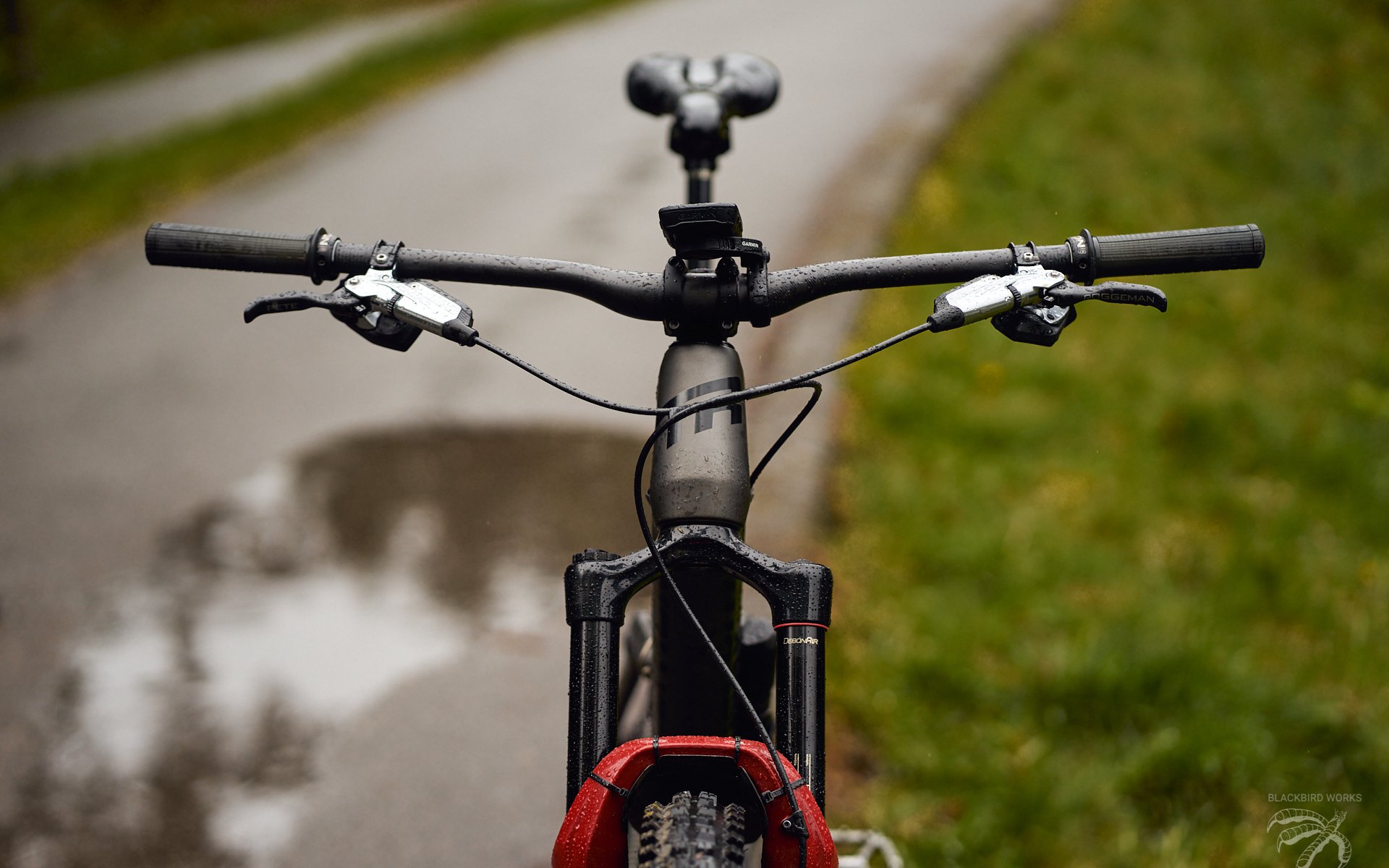
LONG TERM REVIEW
SRAM AXS: a year of wireless shifting
When SRAM released its XO1 and XX1 Eagle AXS wireless drivetrains - as well as the RockShox Reverb AXS Dropper post - reactions were predictable. On one hand, it was celebrated as a marvel of technology. On the other, it was predictably expensive, and detractors pointed out that cable-actuated shifting and dropper posts worked fine, thank you very much. Better than fine, in fact: in early 2019 SRAM was still the dominant 12-speed drivetrain player with fantastic 50-tooth talent across all price levels from XX1 all the way down to NX, and Shimano had released (if not yet delivered) its mighty 12-speed XTR group, whose XT and SLX cousins were only a matter of time. In other words, the MTB drivetrain landscape was in a pretty sweet spot, and now here was SRAM telling the market that they'd raised the price ceiling with tech that most people didn't need.
That didn't mean they didn't want it, however. Somewhat surprising to me was hearing that while SRAM could also easily predict the market's reaction to AXS, they really had no idea about how well it would sell. They needn't have worried.
Electronic shifting was nothing new to mountain bikes, and SRAM had already brought wireless shifting to its road groups by that point, but still - seeing a bike for the first time without shifter or dropper cables (or hoses) was memorable. Years of improvements in internal cable routing and therefore bike aesthetics (to the despair of mechanics everywhere) still didn't prepare me for the first cockpit I saw with two brake cables and nary another wayward black tube disturbing the peace at the front of the bike. #cableporn fanatics rejoiced even if they were forced to exchange more for better.
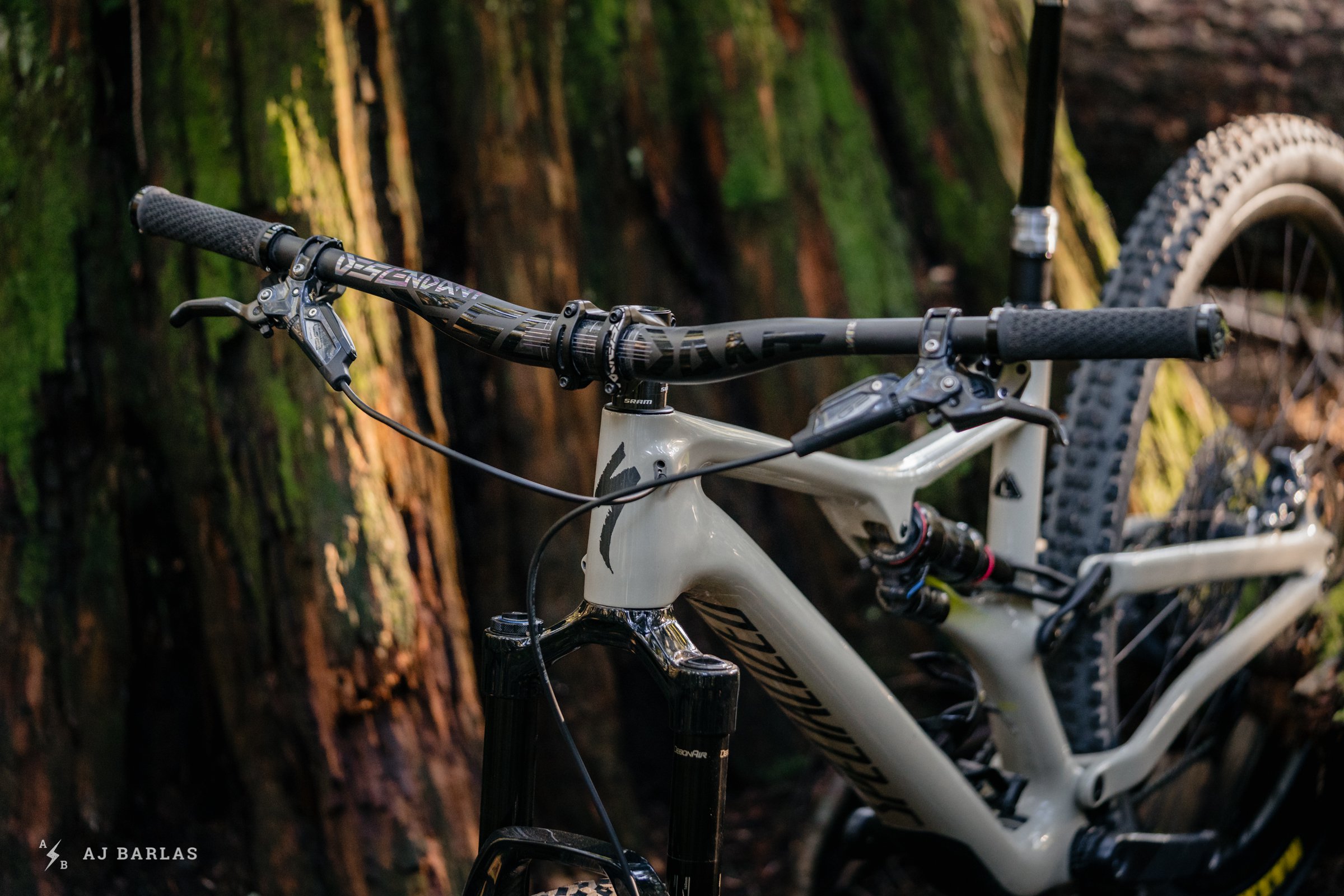
My first ride with AXS happened on a Specialized Stumpjumper, on Seymour. As a first impression it was brief, but lasting. Photo: AJ Barlas
The first ride was, of course, very interesting and informative. You can read about my first impressions with AXS to get the longer version, but the main takeaway was that if SRAM had set expectations high for what AXS could do, I quickly realized that not a single word of what they'd claimed was bullshit. It was every bit as good as their breathless PR led us to believe. That first ride, however, was a very controlled environment - I was riding with North Vancouver-based SRAM marketers Tyler Morland and Ross Measures, on a bike they'd set up, and they were there in case anything went wrong. The true test would have to wait until I got a group installed on a test mule and gave it a proper wringing out over a longer period of time, complete with lots of abusive behaviour like putting it away dirty, or doing the opposite by pressure-washing it, shifting poorly, shifting under load, running the battery down...you get the idea.
That mule was a Mk 1 Transition Sentinel that ably served as an AXS test bed for several months. And then we got word that a new Sentinel was on the way, so I ported the build kit over to the new chassis. I didn't build the first Sentinel, but I did put the second one together, which gave me a chance to experience first hand how incredibly easy it is to install a SRAM AXS Eagle group onto a frame. It goes like this:
- Bolt on the shifter - 1 minute max (even if you drop a bolt on the floor and have to look for it).
- Set the positioning of the paddles - 2 more minutes, give or take.
- Bolt on the derailleur and run the chain - call it 3 minutes.
- Set three limit screws and pair the shifter and derailleur together - 5 minutes max.
- Use the trim function on the shifter (if it's even necessary) - 1 more minute
- Go and ride.
That's, uh...12 minutes. And when I moved everything over to the new Sentinel, I didn't have to touch the limit screws or the trim, but I did need to tweak the B-tension, which is super simple with SRAM's new handheld guide - in fact it takes all uncertainty out of the job. You do, however, need someone else to help you do it quickly and accurately. Conclusion: Eagle AXS is both far quicker, and easier to set up than cable-actuated drivetrains.
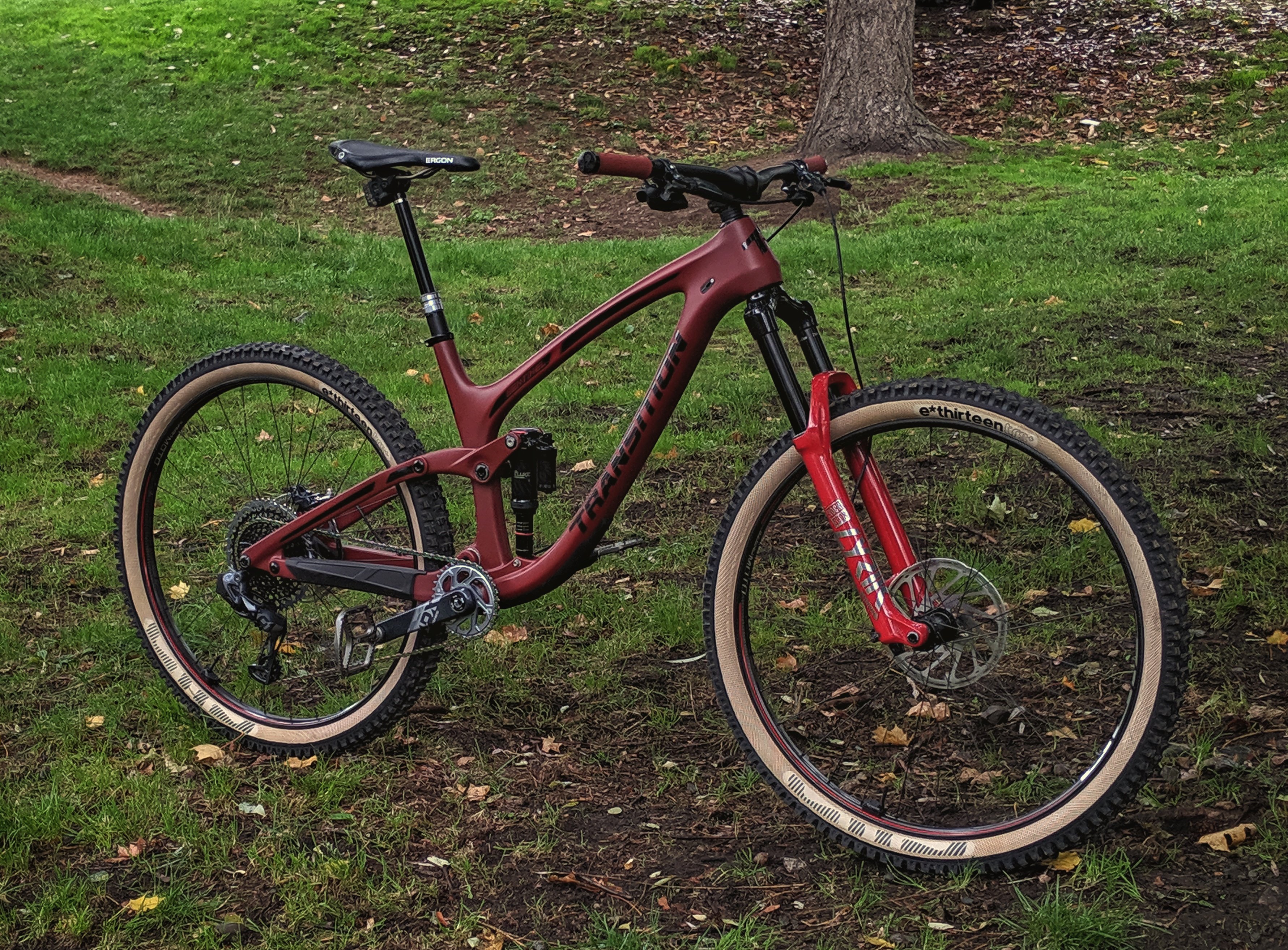
The first home for the SRAM Eagle AXS group was this Mk 1 Transition Sentinel. Photos: Deniz Merdano
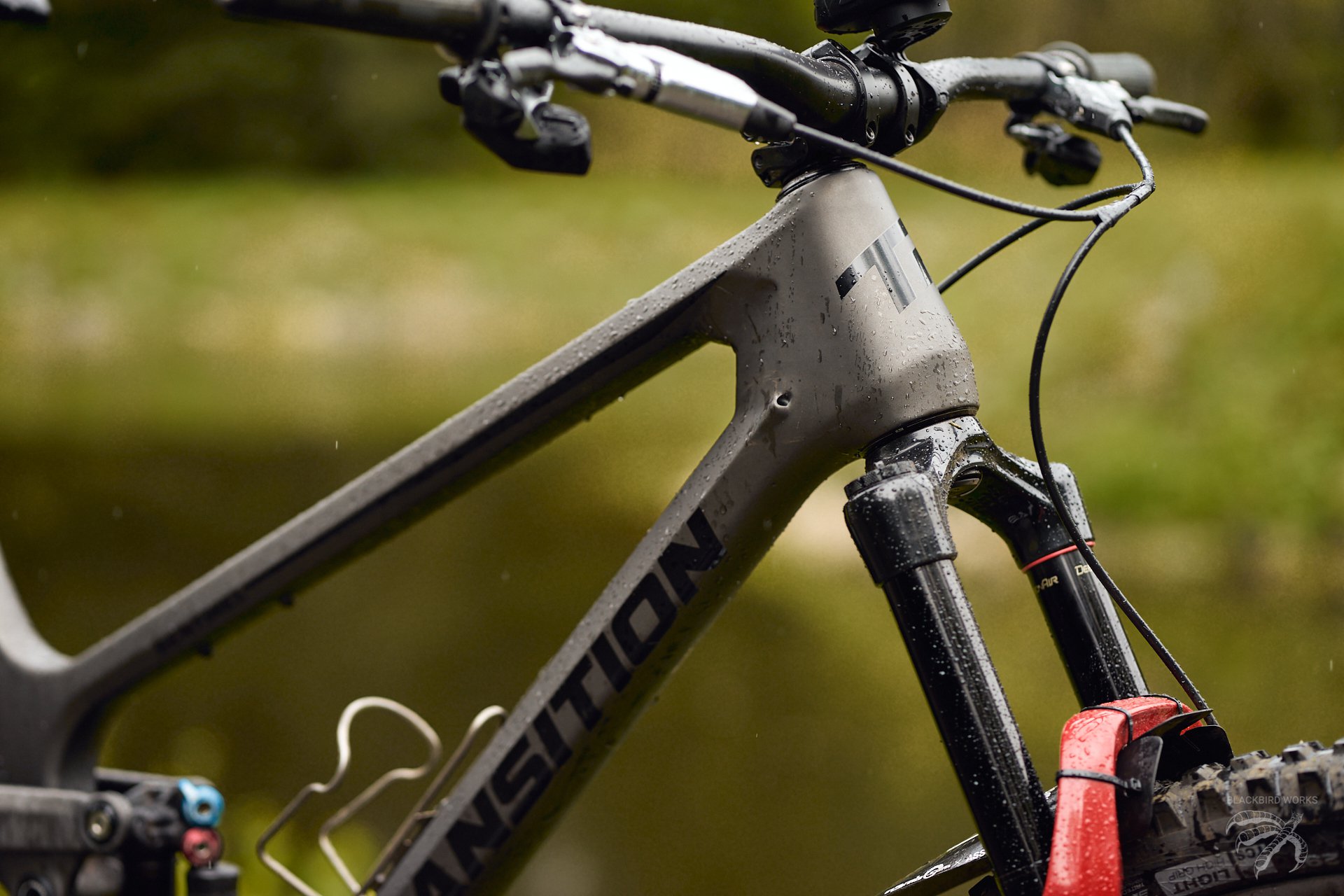
But then we got wind of the new Sentinel, and AXS got a new home.
Many AXS owners won't care about the install and how easy it was, but I still think it's worth noting. And that does bring us to SRAM AXS's cousin, the RockShox AXS Reverb which now holds the crown for being the easiest thing on a bike to install other than grips, maybe.
- Install shifter.
- Install saddle onto post.
- Put post into frame. Tighten clamp bolt.
- Pair shifter and seat post (as easy as pairing bluetooth headphones to a phone, but no app required).
Why am I bothering to explain how easy this all is? Because in the case of the AXS Reverb, you wouldn't be crazy if you decided to run one post across multiple bikes - you would only need to buy an extra shifter, and then just make sure the post is paired each time you move it over to the other bike. And the AXS Reverb is good enough that some people will be considering this, unless their budget simply allows them to pop for a whole other post.
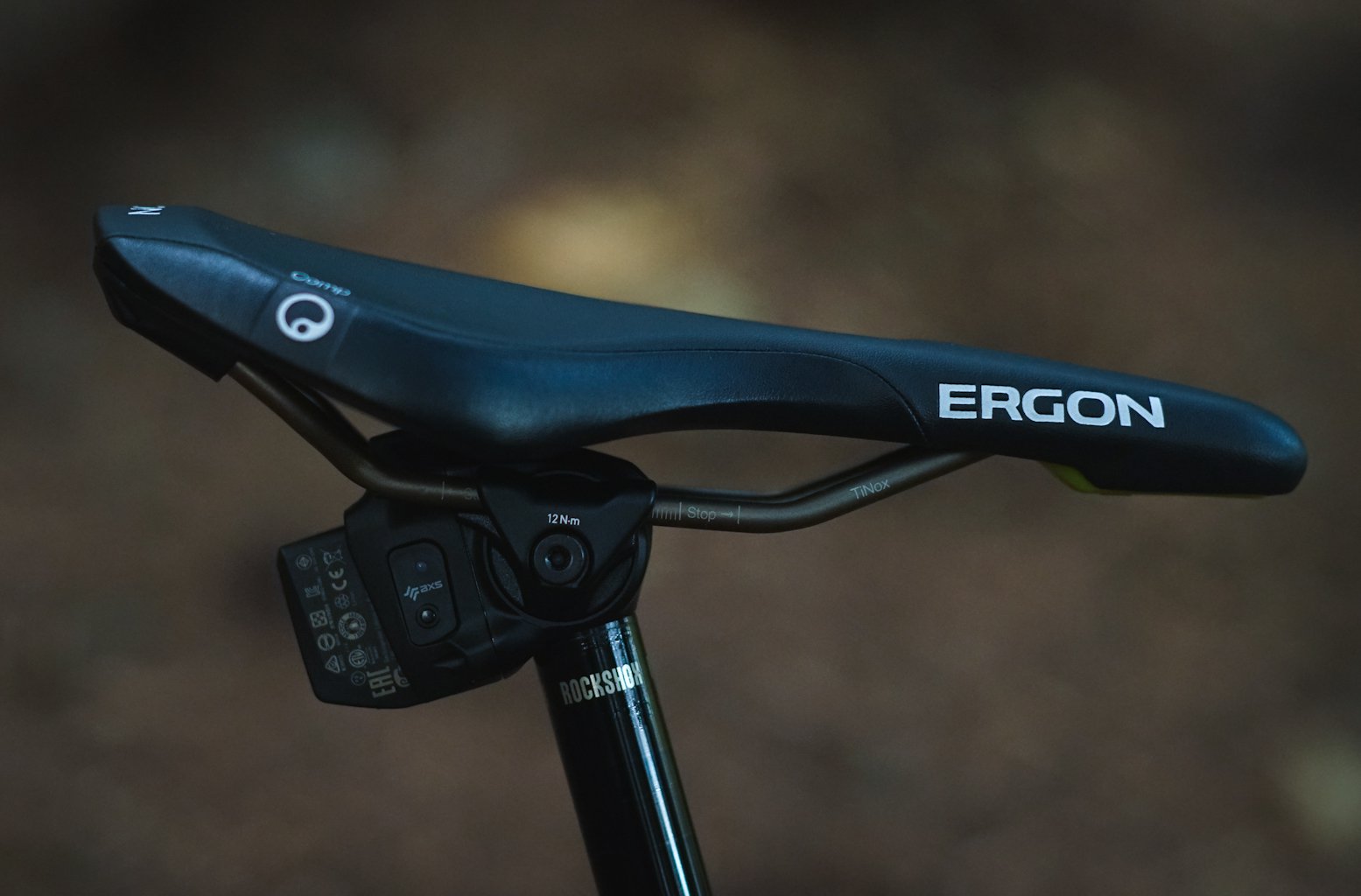
The RockShox Reverb AXS Dropper post looks like any other Reverb except for the battery and housing on the head of the post...
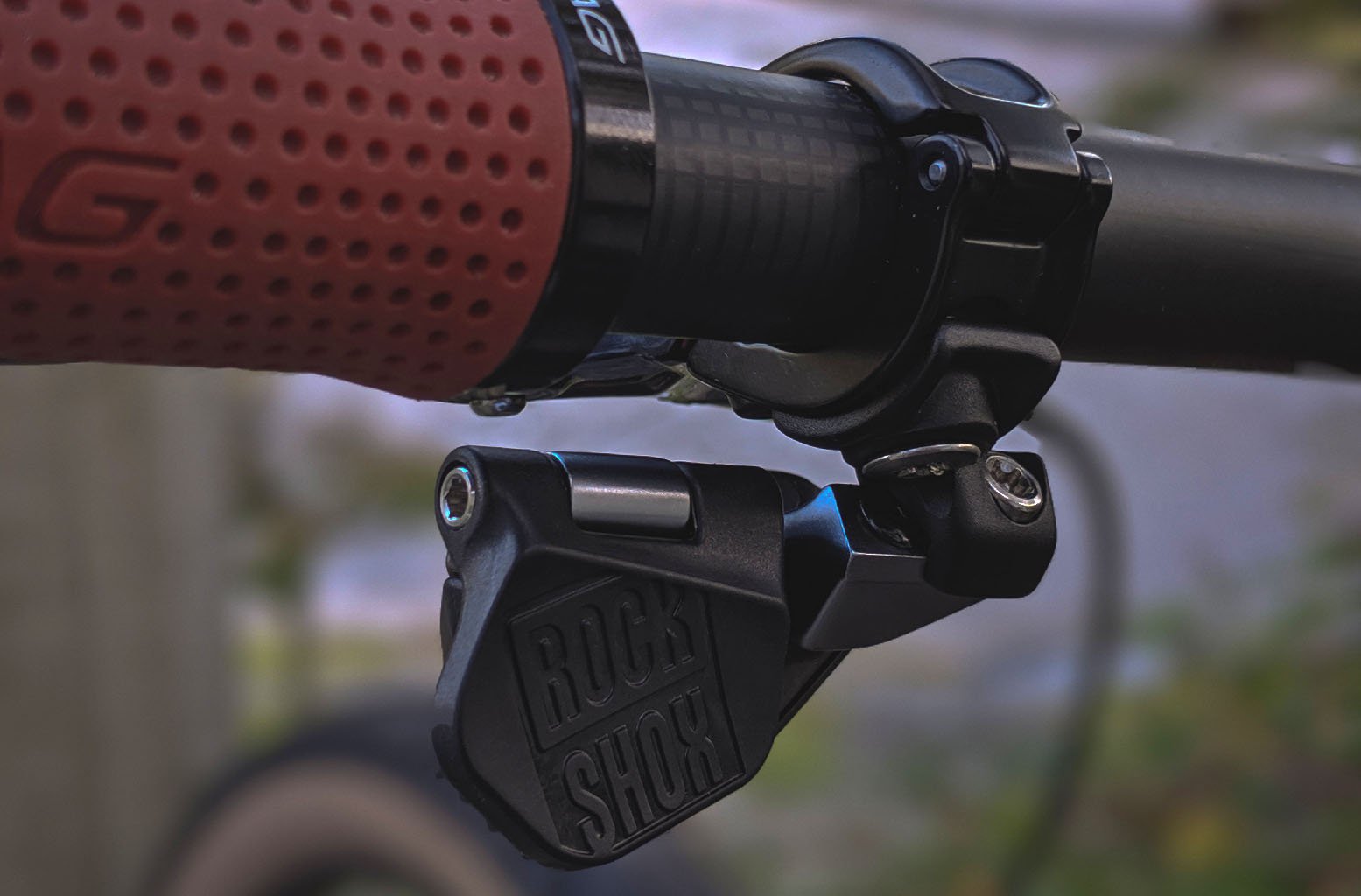
...and of course the shifter looks a bit different, too. Photos: Deniz Merdano
...if SRAM had set expectations high for what AXS could do, I quickly realized that not a single word of what they'd claimed was bullshit. It was every bit as good as their breathless PR led us to believe.
SRAM Eagle AXS in Action
I've had plenty of time to gather my thoughts about AXS over about a year on the group. We've already covered the fact that SRAM's claims were legit: shifting is faster with a much lighter action than cable-actuated Eagle shifters. It's also more accurate: pop the button once and the chain jumps up or down the cassette. Pop it twice or three times in rapid succession and the chain is in place before your thumb returns to the bar. Hold the button - same thing: multiple shifts are executed with ease and perfect accuracy. These are all settings you can play with in the accompanying app, but in my experience you'll do that once or twice and then not go back to it very often. Decide which button you want to correspond to an upshift or downshift, or whether or not to enable multi-shifts when you hold down a button, and off you go.
Battery life is plentiful. I've let the derailleur's battery run down once - it took months to do - but otherwise I just top it up for 20-30 minutes before or after a ride while I'm doing something else, and don't have to think about it otherwise. Except that one time the derailleur battery mysteriously died. It had worked fine, then I gave it a top-off charge, and the next day it didn't wake up. Unfortunately I didn't realize the problem until I got to the trailhead. This left me in an awkward position on a ride, as it meant I had one battery to split between the rear derailleur and the post and I had to do some swaps to accommodate the issue. Solution for future: I keep a spare charger in my truck so I can always top off a battery if I show up with a dead unit at the trailhead. Alternately, both owning a carrying a spare battery is sensible. The other precaution I now take is to make sure to check my battery before leaving on a ride - and while it's a legitimate complaint that it's another thing to worry about, I would contend that it just becomes part of your pre-ride routine, like checking brakes and tire pressure (just press the small button on your derailleur or seat post - green means you're above 50% charge, solid red means below 50%, flashing red means it needs a charge).
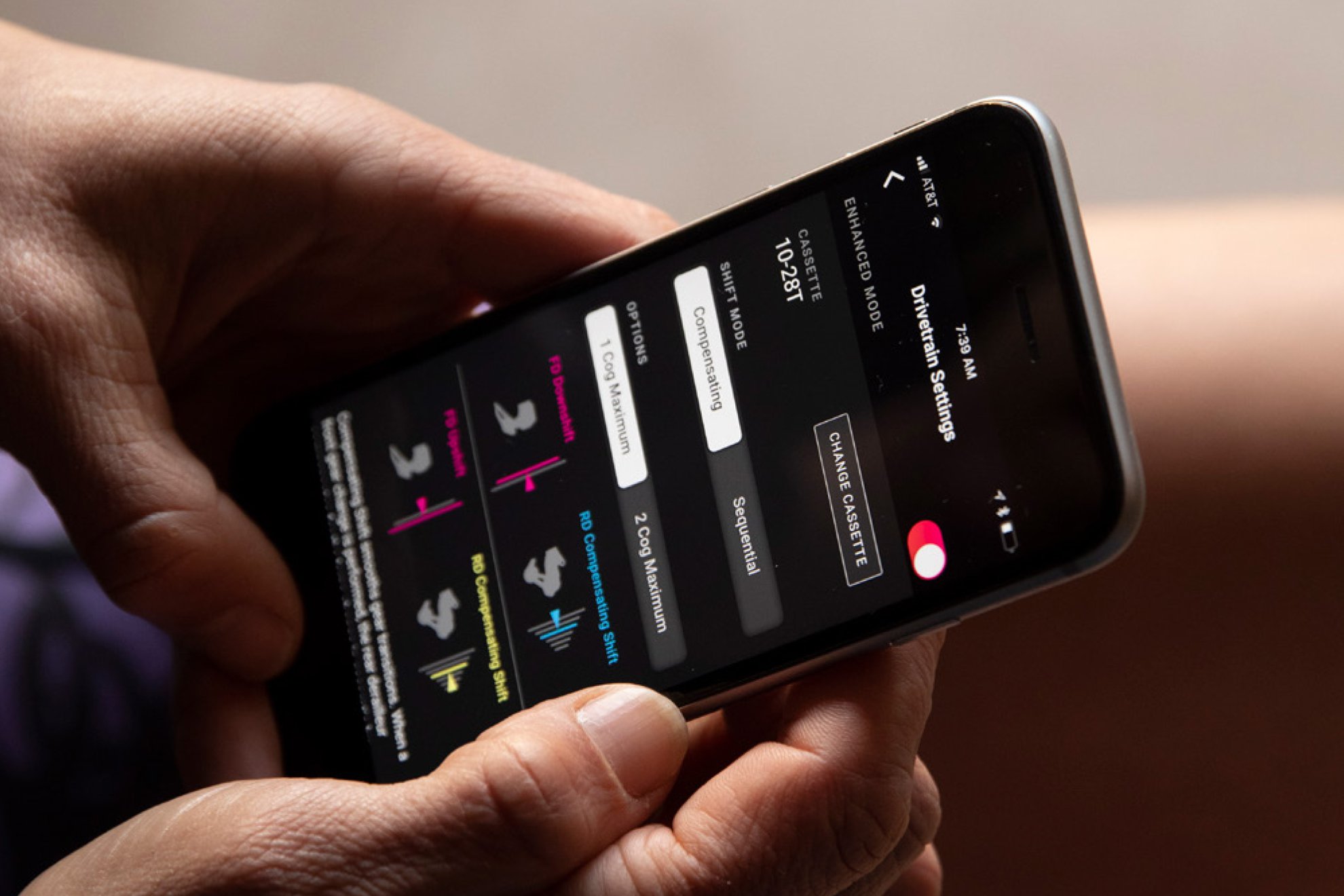
Use SRAM's AXS app to set up your shifter(s) to assign functions to each button like which one shifts up and which one is down, as well as multi shift capability and sensitivity. The app also allows you to monitor the battery levels of the derailleur, post, and coin cell-powered shifters. Additional integrations include use with some Garmin units as well as SRAM-owned Quarq TyreWiz, which I'll write about in the future. Photos in this sequence: AJ Barlas
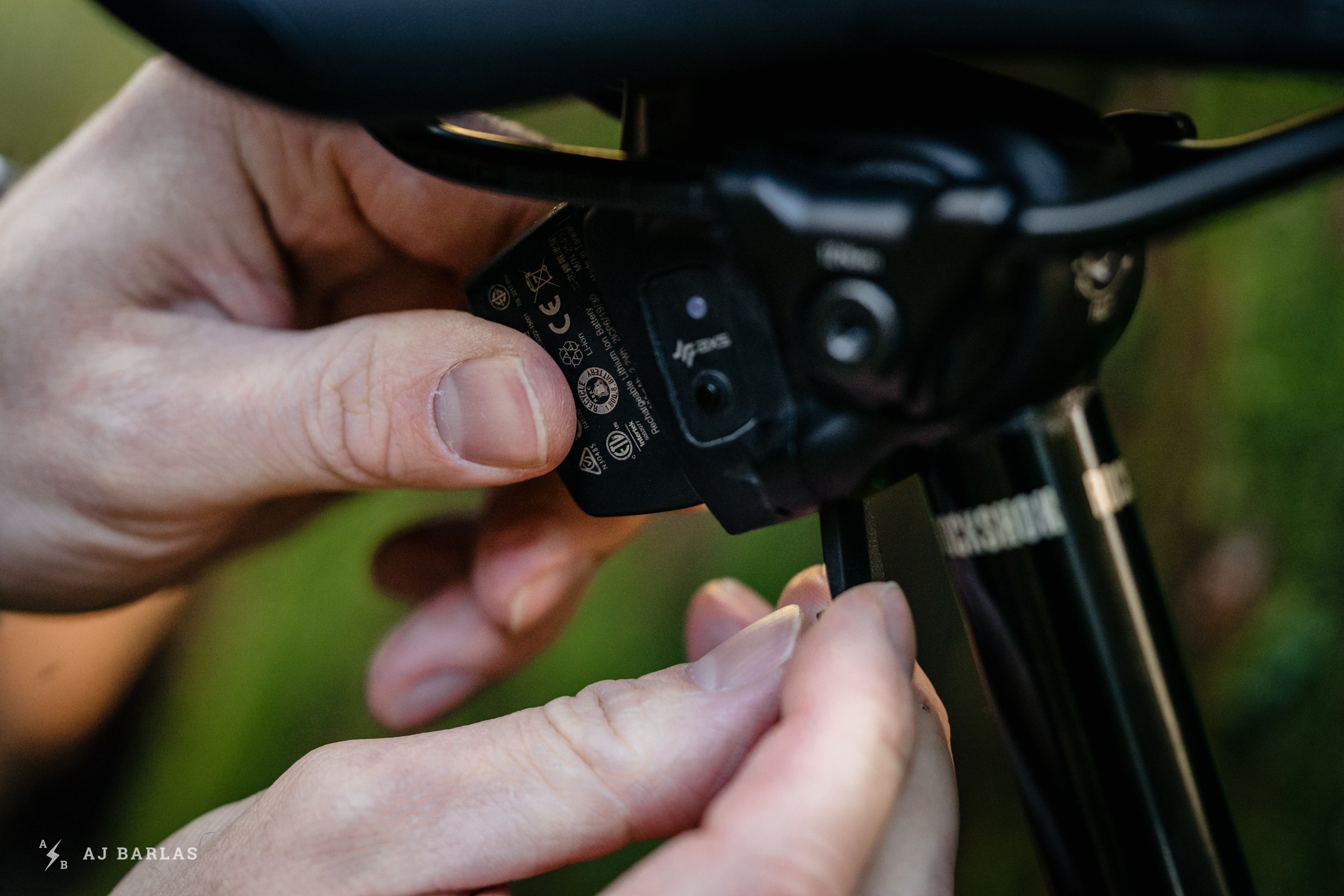
Batteries are easily installed and removed.
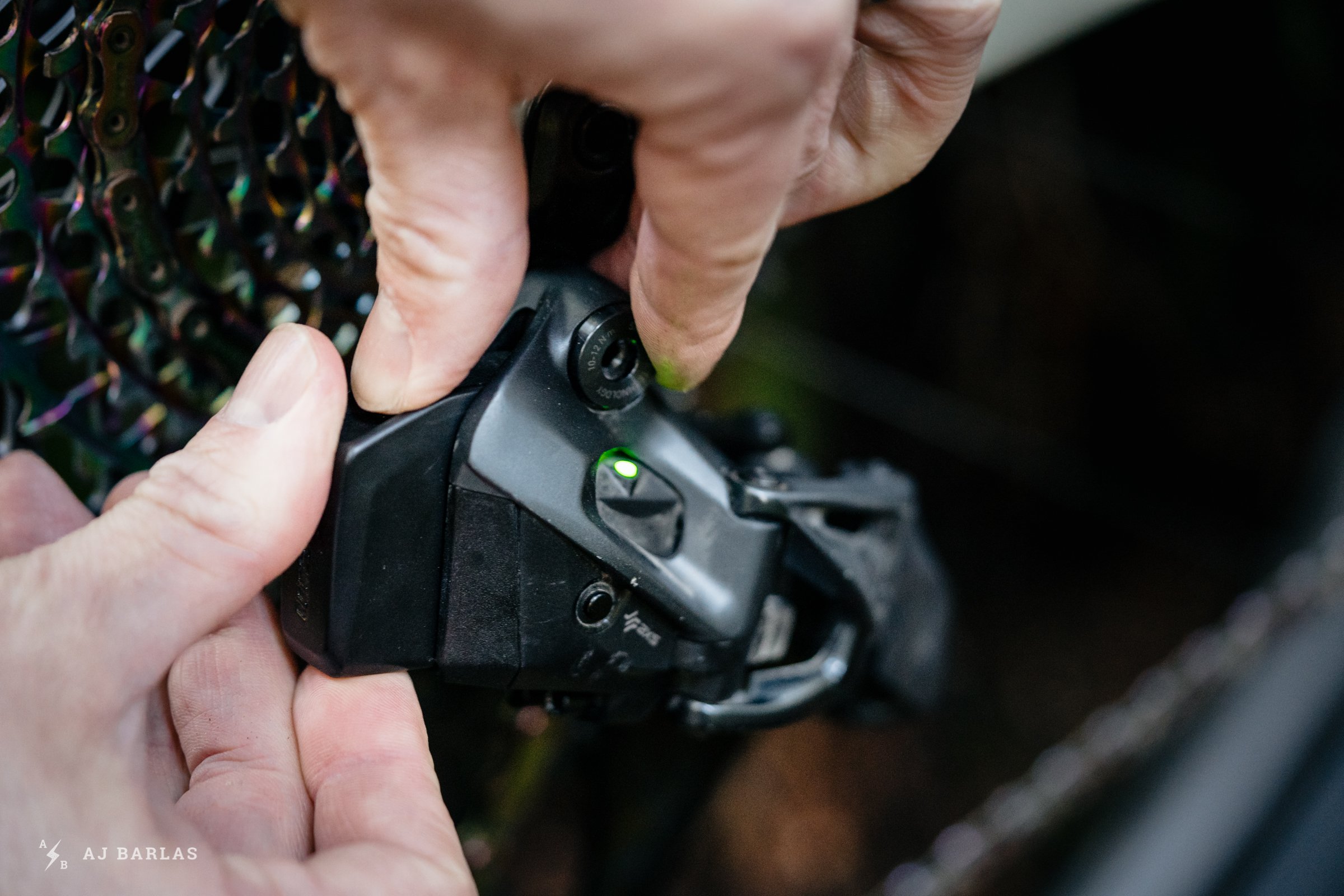
The green light will come on when the contacts are in touch, letting you know you've got juice.
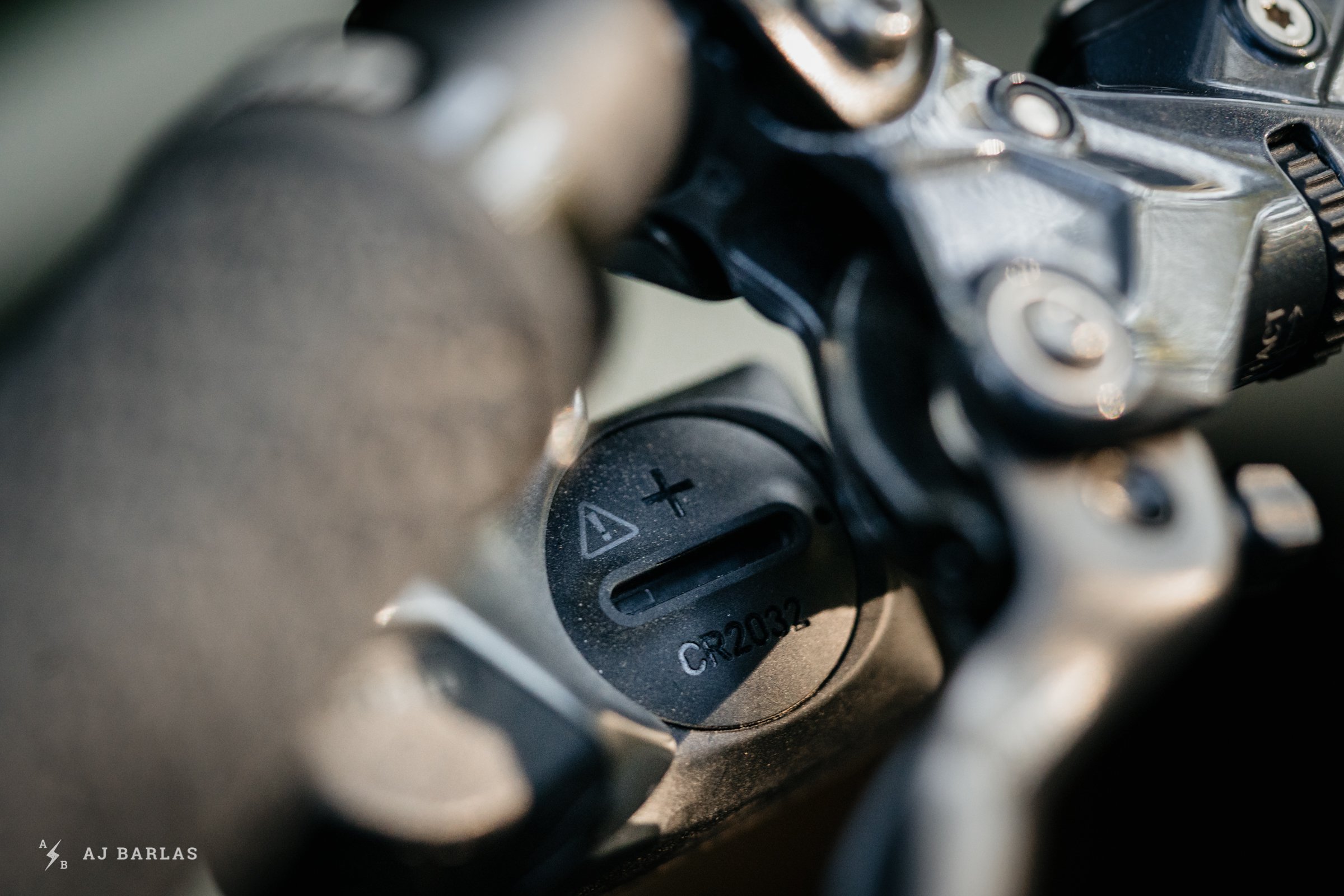
Shift units are controlled by CR 2032 batteries - easy to source, cheap, and long-lasting. SRAM's AXS app also monitors their longevity, and it'll send you an alert if they run low, so you shouldn't be taken by surprise.
If the speed and accuracy of AXS in use is clear, one thing that needs to be noted is that the ergonomics of the shifter take some getting used to. At first, my brain that was well-conditioned to transition easily between SRAM and Shimano drivetrains had a bit of trouble remembering where to press with my thumb to shift up or down. This resulted in a few mis-shifts and occasional hilarity. Getting used to it was a matter of only a few rides, but it's important to note that the AXS paddle is different than the shifters we're used to. SRAM recently released a revised AXS rocker paddle that only costs $20, which I prefer to the original.
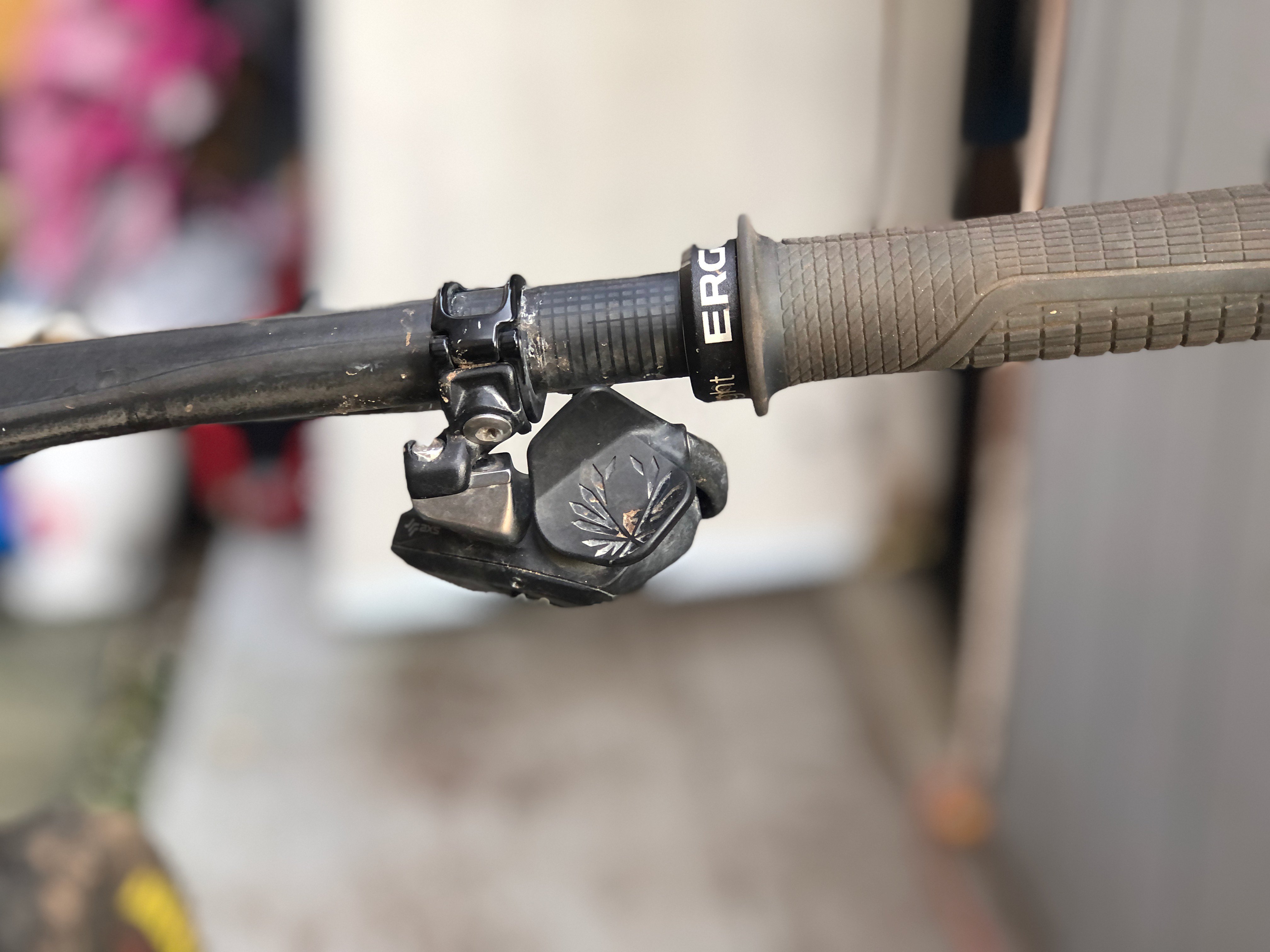
The original Eagle AXS rocker paddle is activated by pressing the top or bottom of the face plate. It's quick but takes a bit of getting used to before it's 100% intuitive. Photo: Pete Roggeman
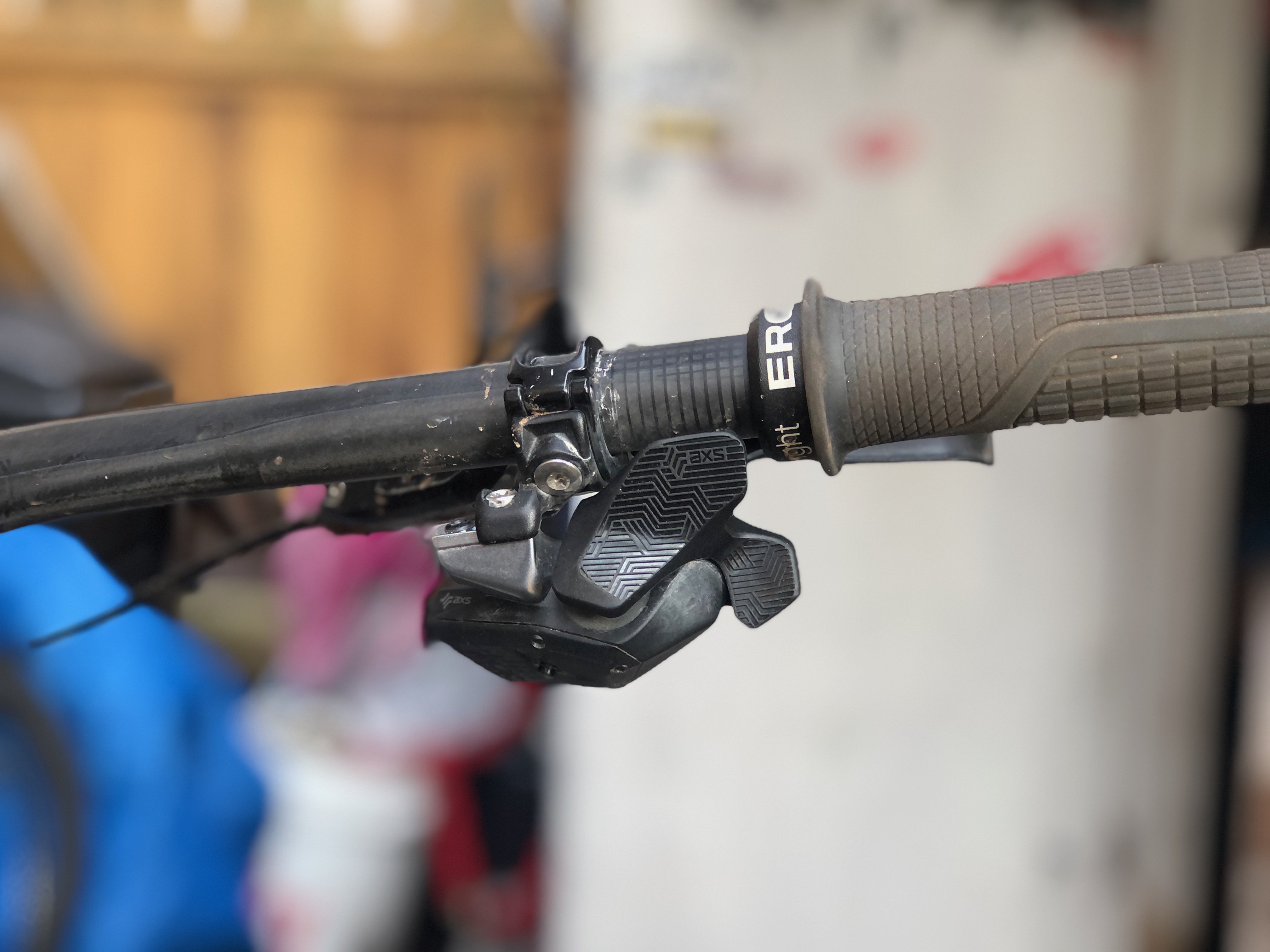
The recently released revised Eagle AXS rocker paddle has a slightly more familiar layout. The paddle on the lower right side is easier to find when you need a quick shift. I much prefer the new configuration. Photo: Pete Roggeman
So Eagle AXS is fast, accurate, removes visual complexity from your bike in favour of technical complexity, and is certainly a net performance gain for those willing to fork over the $1900 US MSRP for an entire XO1 Eagle AXS groupset, or $1,000 for an upgrade kit consisting of AXS derailleur, controller, charger and battery (although you're likely to find discounted Eagle AXS pricing online, at least on complete groupsets including crank, BB, and cassette).
One huge glaring red flag is the risk of smashing that $700 derailleur on a rock and ruining it. Fairly concerning, I'd agree, and perhaps the one place I thought a long-term test might expose a glaring weakness in Eagle AXS. But SRAM's engineers cleverly included an overload clutch. What that does is detect an impact from the side and automagically moves the derailleur inboard. You can replicate it yourself by giving the derailleur a sideways whack (be a bit careful). Right before your eyes, it'll pop in towards the cassette, and then pop back out again. Of course you could still smash the hell out of it and cause terminal damage, but have a look at the condition of my AXS derailleur in the photo below. It's taken a beating and still shifts perfectly. I don't know if that's worth $700 or not - but I can say that I'm really impressed with how durable that unit has turned out to be, and that I would have likely had to replace it once or even twice if it were a GX or XO1 derailleur.
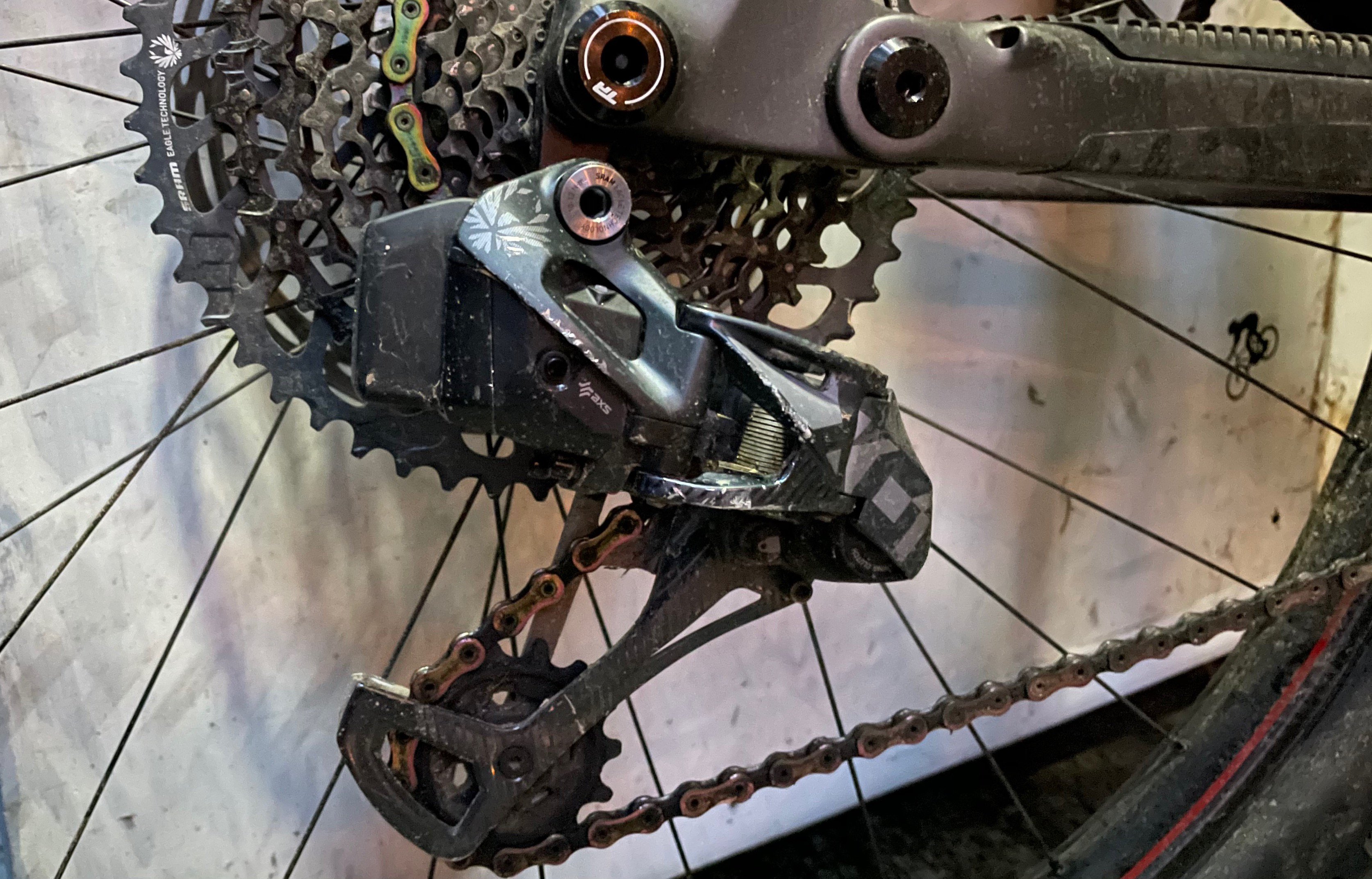
Battle scars! The AXS derailleur's overload clutch has clearly been serving this unit well. Photo: Pete Roggeman
Conclusion
After a year on SRAM Eagle AXS, I am continuously struck by how well it works. It has been used hard, never babied, and has not complained once. The only issue I've had was the one time the battery seemed to crap out mysteriously - and a quick visit to the charger fixed that. Otherwise, it has shifted with remarkably consistent speed and accuracy, and the durability of SRAM's XO1 components - chain and cassette most notably, but also the remarkable AXS derailleur - is well intact.
The cost of bleeding edge technology is always hard to swallow, and although I'd argue that Eagle AXS is actually not that much more than a XX1 or XO1 groupset when you factor in the technology that's included (or the fact that you can get an entire XO1 Eagle AXS groupset for $1,520 US online right now), the reasons not to spring for AXS aren't hard to conjure: existing high-end drivetrains are already incredibly fast, accurate, and durable. We're not lacking for performance even as we go down from XO1 to GX. For some, however, the technology is fascinating. Nothing about AXS changes which camp you belong to: it may contribute joy to your rides, whether you appreciate the cleaner looking bike, the faster, more accurate shifts, or the knowledge that robots are riding shotgun. Take heart if this isn't you, however. If you live to min/max your bike's performance, your money is better spent elsewhere, but then, you already knew that.
Is it for you?
I can't wholeheartedly recommend that everyone buys it, obviously. But that doesn't mean I don't recommend it. It's a marvel of technology that works as advertised. For first generation technology, that's a remarkable achievement. Marrying finely-tuned wireless tech with the rigorous demands of technical mountain biking is a bit of an insane ask, frankly, but it's also a direction more and more brands are exploring as they seek a new edge in the progression of our sport. Not many will be able to execute the feat that SRAM has pulled off with AXS. I share your hope that they figure out a way to trickle it down to lower price points, but that also is not as simple as trickling down tech in other bike components, because it's not a matter of swapping out higher-end materials for lesser ones - it's the technology that costs a lot with AXS.
You definitely don't need robots doing your shifting for you, and I don't feel sad when I switch back to a bike that doesn't have AXS equipped. But if the technology intrigues you and you can afford it, I can say with confidence that you won't regret it.
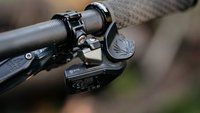

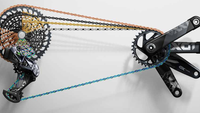
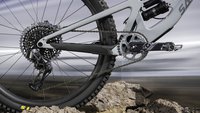







Comments
Lynx .
3 years, 5 months ago
Let me just use this abbreviation N.F.F., don't want anything electronic on a bike, especially MTB. No personal use experience on any of it, but going from clients experience and a friend, yeah, no thanks. If you're in the US or major country with authorised SRAM dealers close by, then no worries, but if you live anywhere else, then you're fvcked if, like my friend, your $600 derailleur just up and dies. Or my other friend who's shifter mysteriously eats button batteries, so that now he removes the battery after every ride.
That $hit is WAY too expensive, when I can get a perfectly function 12spd SLX or even XT group for what or less than what the rear derailleur cost and if the cable breaks on the trail, heaven forbid, I can simply set the limit screws to put it into a useable gear and when stuff fails out here in the real world, I don't feel bad about replacing with same quality for a fraction of the cost.
Reply
Cr4w
3 years, 5 months ago
I'm probably not the target user for AXS but I think it's cool that it lives up to claims and expectations. It's an impressive technological accomplishment.
Reply
DanL
3 years, 5 months ago
Me neither, but I would definitely lean towards an AXS dropper post as out of all the things that annoy me, routing and re-routing dropper cables top the list
Reply
Pete Roggeman
3 years, 5 months ago
I deliberately didn't get into the Reverb AXS post, but that's in the future, including a tear down. And yes, I understand that sentiment and have chatted with lots of people who feel the same way - going wireless may make more sense with your dropper than with your shifting.
Reply
DanL
3 years, 5 months ago
And, if I was really trying to gucci min-max, I could swap the dropper between bikes and count that into the total cost savings, right? Right?
Reply
Pete Roggeman
3 years, 5 months ago
Of course!
Reply
MuscogeeMasher
3 years, 5 months ago
Are you adjusting the saddle tilt when swapping between bikes?
Mammal
3 years, 5 months ago
I know... For another time. But, I have to.
One of the biggest deterrents to the age-old reverb internal design, is the cost of the service, and/or the complexity of servicing it yourself. At least when compared to almost every other cartridge brand these days.
If you use one dropper for all bikes (2 or more), you need to consider that the wear the dropper will see, will likely double (or tripple). So you'll pay for an actuator for each bike, and an accelerated maintenance schedule for an expensive product to service. In my opinion, the value aspect just isn't there, over purchasing multiple cartridge droppers.
Reply
Pete Roggeman
3 years, 5 months ago
You can only ride one bike at once, so I don't see how your wear/service interval increases 2 or 3x. It's the same number of ride hours, just all on one post instead of 2 or 3. I've been running two Reverbs for over a year, neither has needed service yet...
Your argument could propose that relying on one post means you're vulnerable to being without a post when it needs maintenance, but a bit of planning should mitigate that issue in most cases.
Reply
Mammal
3 years, 5 months ago
I suppose my comment is based on my Reverb experience. On average, 1 service per year, for the 4 or 5 years I had it (only did the full service myself once). Alternatively, since I've moved to cartridge posts (2), I have yet to replace a cartridge in over 2 years of riding each of those, and all they've needed is some collar grease and a set of pins/bushing for one of them ($30 - 5 minute job at home).
Although the aggregate riding time is the same in both cases, by using a single Reverb post, you'll be putting all those miles on the post that's more expensive to service. So according to my dropper experience, over a period of 2 years or more, you're already in for a more expensive setup by buying one AXS reverb and 2 (or more) activator levers. And if we're considering that the AXS costs $800 USD to start with... I just can't see where the value lies.
Chad K
3 years, 5 months ago
Mammal, based on your comments, I think you also might have been on the older internal design for the Reverb, which got an update with the newer AXS launch.
I'd also argue that if you are moving the dropper (already undoing one bolt), you might was well move the actuator, too. All you would need is a clamp on each handlebar so you could just put it right into place. That's significantly less than the cost of a second actuator
Reply
AndrewR
3 years, 5 months ago
@Chad K
Exactly either install a matchmaker or the individual mount (that comes with the Reverb AXS anyway) and switch both shifter and seat post between bikes. Probably no more than a 5 minute job including being OCD about seat angle/ saddle rail position if that needs adjusting and checking everything with a torque wrench.
Check the seat post bleed & air pressure every 50 hours and you are good to go. It is seriously an impressive piece of kit and flawless for 2639 km of riding.
Michael Klein
3 years, 5 months ago
This is why you should never leave an AXS bike out of sight. If someone decides they need that dropper more than you, all it takes is undoing two bolts.
Onawalk
3 years, 5 months ago
All I want for Christmas is a dropper post that retracts, as well as extends automagically.
I had high hopes that this post would be the answer, but alas, no such luck
Reply
Jerry Willows
3 years, 5 months ago
This comment has been removed.
RNAYEL
3 years, 5 months ago
I have AXS XX1 on my new FS bike and X01 Eagle on my hardtail. The only annoyance I find with AXS is that downshifting isn't as intuitive as with the mechanical setup. I think that the recently released paddle fixes that. I do love however the ability to just push the paddle and pedal until you're in the desired gear. No need to keep clicking the shifter.
I am also impressed at the accuracy of the electronic shifting, it just goes through the gears and never complains or rubs.
Reply
AndrewR
3 years, 5 months ago
Intuitive is dependent on your ability to adapt to a system that does not have mechanical leverage limitations. The requirement to move a certain length of cable with a thumb dictates a certain design. The ability to shift cleanly by depressing a button about 0.2mm frees up the shifter for a total redesign.
That said I have modified my AXS shifter paddles (version 1.3 and version 2.3) to remove the parts that block natural thumb extension and with recesses that catch the thumb naturally so that I can shift, in either direction, with literally a twitch of thumb.
Reply
Agleck7
3 years, 5 months ago
Now I want the full Sentinel review :)
Reply
Morgan Heater
3 years, 5 months ago
I have to admit that if I had extra money to burn I would buy this in a minute just for how clean the cockpit looks.
Reply
IslandLife
3 years, 5 months ago
Damn... that clean bar/set-up is almost worth the price of admission... almost... well, not really. Does look good though! Are wireless brakes next?! haha...
Reply
Lynx .
3 years, 5 months ago
Actually, yes, they are already working on that insanity. I say insanity, because trusting your brakes on an MTB to a fly by wire system is not the best choice IMHO going by my experience with vehicles and throttle control - almost got slammed into the wall with a faulty one that wasn't working right and didn't accelerate at first press on the pedal, pressed harder and then it kicked in and luckily I was paying attention.
Reply
Peter Adamkovics
3 years, 5 months ago
if only they would make the derailleur programmable for 11speed (or less) cassettes, i'd be in.
i dont want 12speed, but would love to use this with my 11speed drivetrain.
Reply
IslandLife
3 years, 5 months ago
What's the warranty situation/length with this system? Standard 2 years? If it just craps out in year 3... are there spare parts available for the motors and other items? Is it service-able?
I'm assuming they must be working on a GX version of this... and probably working on getting the price down. If a GX AXS was a few hundred dollar upgrade from regular GX, I'd be all over that. A GX version would also be a huge headache for Shimano... who would probably have to speed up the development of their Di2.0 (which I'm assuming is in rapid development??).
Who knows, they may have GX AXS waiting in the wings but won't bother releasing it until they have some competition?
Reply
Pete Roggeman
3 years, 5 months ago
I didn't find warranty info at sram.com but I'd assume it's the same as all of their other products, which should be 2 years as that's the law in Europe. Spare part availability is another question entirely and I've put that question to SRAM for comment.
It's doubtful a GX version would only cost a few hundred dollars more than regular GX. Rather, you should think of it as costing a few hundred dollars less than XO1 AXS. Remember, we're just talking about the derailleur and controller. I doubt there's any money to be saved in the controller, other than perhaps eliminating the 'knuckle button' which was a request from Nino Schurter (and I hardly ever use) and all you could save in the derailleur would be based on lower-cost materials. The wireless elements are going to be the same or similar.
If it was ready, it would be released. By the time all that engineering and planning is invested, there's no holding back on products, at least in regular times. SRAM now has plenty of competition as all of a sudden Shimano's lower-tier 12-speed groups are getting plenty of spec. That's a bullet SRAM would gladly chamber.
Reply
Pete Roggeman
3 years, 5 months ago
The answer I had back from SRAM was that warranty is two years and works the same as all their other products. Work with your retailer, save your receipt, etc. I don't think serviceability or repairability is going to differ from other componentry. Small electric motors like the ones used in the derailleur are very common these days and not that prone to breakage.
Reply
Sean Chee
3 years, 5 months ago
The electronic elements of the system cost next to nothing. I firmly believe they could easily do axs versions of any drive train for less than $100 more than conventional. They wont though until a serious competitive option sparks a price war.
Reply
IslandLife
3 years, 5 months ago
Ya, I guess I'm thinking there's not much in there that justifies the current price jump from non-AXS to AXS... I'm thinking with zero competition (wireless electronic shifting) that there is some serious margin on AXS right now. I think no matter how much Shimano might be beginning to eat their lunch with the new Deore... they are probably enjoying those profit margins right now. Depends what Shimano does with wireless Di2 though... if they decide to go the route of high margins then we won't see much of a price drop, even with a GX version. Its also the "premium halo product" of their lineup which might also keep prices quite high (along with margins) for a number of years to come. Interesting times for sure.
Reply
Andy Eunson
3 years, 5 months ago
I ran Ultegra DI2 on a cross bike for a few years. It worked really well. I had a misalignment issue once that I remedied while riding. Never ran out of juice and a charge lasted months. But was it that much better than mechanical? Not for me. I had mechanical Dura Ace on my road bike at the time and worked just as well. But on full suspension bikes, cable routing is often such that there are numerous bends that make mechanical shifting stiff. I have XO1 on a hardtail and full suspension. The full suspension is always stiffer to shift. Not a big deal but it bothers me never the less. That I think is the big plus of electric. Zero cable routing issues.
Internal cable routing must be a conspiracy by the electric shifting group. It’s such a pain in the ass to route internal shift housing in most cases that we all leave it too long before we change our cables and housing.
Reply
Sean Chee
3 years, 5 months ago
It's 2020 and you're telling me the shifters for my rolls royce bike needs disposable batteries? Why can't I just plug in a usb cable like basically every other piece of wireless technology?
As a lover of the planet, it's a big negative for AXS as it stands. It wont be long until they start appearing discarded at trail heads. At least cables are 95%+ recyclable.
As a developer of IoT technology, I think it's lazy. When shimano claps back next, they won't make the same mistake.
Reply
Pete Roggeman
3 years, 5 months ago
I don't disagree, but I think it's a stretch to say we'll be seeing batteries discarded at trail heads...
Reply
Chad K
3 years, 5 months ago
Based on how long the batteries in the shifters last, I highly doubt you'd see them discarded around trailheads. I've had a set of batteries running in a set of Force ETAP shifters with over a year and a half of use and I don't think they are even close to running out.
Reply
Chad K
3 years, 5 months ago
This comment has been removed.
ohio
3 years, 5 months ago
Given the choice between not having to touch your shifter for years, and having to plug it in monthly, I'd say it's a pragmatic choice, especially when you start to factor In water ingress and either a quick release shifter or requiring the user to colocate their bikes with outlets. Even the Tesla key fob uses a coin cell. It makes good sense for the low power RF protocol SRAM Is using (I believe Zigbee)
Reply
AndrewR
3 years, 5 months ago
If you use the app once per month it will tell you the state of all batteries and you can replace the CR2032 batteries (projected for 200 hrs use) in the safety of your own workshop and then recycle them in the correct recycling bin.
But I fully agree that there is scope for them to modify the shifters so that they use a rechargeable (and recyclable at end of life) battery.
Reply
Sean Chee
3 years, 5 months ago
IPXX rated usb c connectors are on phones everywhere. Li ion button style cells are cheap and easy to implement. You don't even need a connector with inductive charging. It's not like the technology isn't mature.
Coin cells are in key fobs because many cars charge them. I haven't changed them in my keys after 13 years. You'll see them disappearing in coming years though.
Responsible users will of course dispose of them properly, but we all know it's not a world full of angels.
Reply
Please log in to leave a comment.